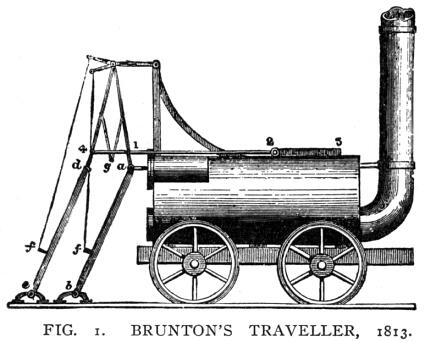- Steam Horse locomotive
Infobox Locomotive
name=Brunton's Mechanical Traveller I
powertype=Steam

caption=Brunton's Mechanical Traveller
builder=William Brunton
builddate=c. 1813
railroad=Butterley Ironworks
gauge=
whytetype=Four wheels, not driven
retiredate=
boilerpressure=40lb/in2
cylindercount=1
cylindersize=6x24 inches
(152x610 mm)
weight=2¼ Tons
topspeed=convert|3|mph|km/h|1
currentowner=
disposition=Infobox Locomotive
name=Brunton's Mechanical Traveller II
powertype=Steam
caption=
builder=William Brunton
builddate= October 1814
railroad=Newbottle Colliery
gauge=
whytetype=Four wheels, not driven
retiredate=31 July 1815
boilerpressure=|
cylindercount=1 or 2
cylindersize=
weight=5 Tons
topspeed=convert|2.5|mph|km/h|1
currentowner=
disposition=destroyed byboiler explosion
The Steam Horse was constructed by theButterley Company inDerbyshire in 1813 byWilliam Brunton (1777-1851). Also known as the "mechanical traveller" it had a pair of mechanical legs, with feet that gripped the rails at the rear of the engine to push it forwards at about three miles an hour.Design
To modern readers it may seem a comical contraption, but it provides an interesting insight into railway thought at the time. The collieries were well served between towns by the canal system. From the pithead to the canals, horse-drawn
wagonways had been constructed and steam engines were seen as no more than a noisy and dangerous novelty. However theNapoleonic Wars from 1799 to 1815 had brought a great increase in the price of fodder. Moreover, some such "railways" were being constructed on the steeper gradients within canals, as for instance on theCharnwood Forest Canal .Nobody believed that steel wheels on smooth steel rails would give enough adhesion until Stephenson and Hedley proved otherwise in 1813 and even the former considered 1 in 100 was the absolute maximum. Consequently such steam operated systems as there were, were operated by cumbersome cables, or by the use of an expensive rack and pinion.
Crich
This makes Brunton's idea seem more reasonable, given that the Butterley Company were faced with a gradient of 1 in 50 between its limeworks at
Crich to theCromford Canal at Amber Wharf, some convert|1.25|mi|km|2 away. Brunton took out apatent , No. 3700, dated22 May 1813 for the locomotive.cite web | url = http://www.steamindex.com/people/engrs.htm| publisher = Steam index| title = Brief Biographies of Major Mechanical Engineers | accessdate = 2008-03-22] The Butterley locomotive cost a total of £240.cite web | url = http://www.locos-in-profile.co.uk/Articles/Early_Locos/early2.html| publisher = Locos in Profile| title = Pre-1825 locomotives - 2| accessdate = 2008-03-22]Newbottle
The historical record is scanty but it seems that the Steam Horse operated successfully for an unknown period. So much so, that another, larger, one seems to have been built for the Newbottle Colliery, in
County Durham . This locomotive cost £540 and may have had two cylinders.cite web | url = http://www.locos-in-profile.co.uk/Articles/Early_Locos/early4.html| publisher = Locos in Profile| title = Pre-1825 locomotives - 4| accessdate = 2008-03-22] During1814 and1815 it hauled loads up a 1 in 36 gradient at convert|3|mph|km/h|1, but the colliery owners were not happy with it. On31 July 1815 , during a demonstration, the new wrought iron boiler exploded, killing thirteen spectators and injuring several others, and the idea was not pursued.cite web | url = http://www.lordbrunton.com/cameron/default.asp?id=900012&seq=0| publisher = Lord Brunton online| title = Bruntons In History| accessdate = 2008-03-22] cite web | url = http://www.catskillarchive.com/rrextra/odcuri.Html| publisher = Catskill Archive| title = Curiosities of Locomotive Design| accessdate = 2008-03-22] This incident was the first recorded railway disaster.References
* Loughnan St. L.Pendred (1921) "A Note on Brunton's Steam Horse, 1813,"Transactions of The Newcomen Society 02 (1921) : 118-120 [http://www.newcomen.com/transactions/steam.htm available on line]
Wikimedia Foundation. 2010.
